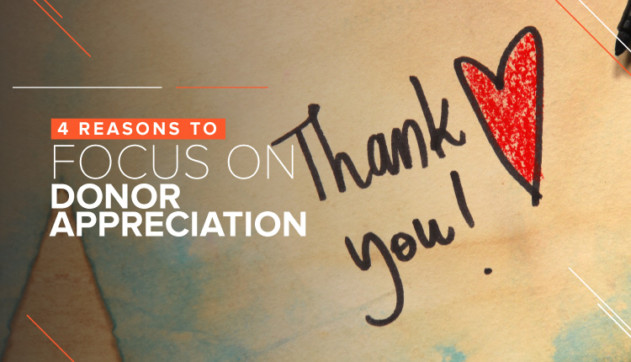4 Reasons to Focus on Donor Appreciation

Your nonprofit relies on the generosity of others to support its mission and further its cause. Without a concrete item or service to offer donors in exchange for their support, what can you do to ensure they feel satisfied with their experience and continuously return to support your programs?
Donor appreciation is the practice of expressing gratitude to those who have generously contributed to support your organization’s programs and operations. Thanking your donors, recognizing them publicly, inviting them to events, and giving them gifts are just some of the ways your organization can show appreciation and make supporters more likely to give again.
At Eleven Fifty Seven, we understand the importance of showing appreciation for your donors—we’ve seen firsthand what appropriate donor recognition can do for nonprofits’ fundraising programs. Over the years, we’ve learned just how much gestures of appreciation can:
- Strengthen donor relationships
- Increase donor retention
- Encourage donors to give more
- Inspire others to give
Knowing how to properly thank donors—and implementing these appreciation strategies consistently—can help your nonprofit reach its goals and expand your mission. Let’s dive into the specifics.
1. Strengthen Donor Relationships
Nonprofits thrive when they have real, genuine relationships with donors, rather than purely transactional ones. Have you ever had a friend who failed to thank you for a thoughtful gift, but continued to ask for more? If so, you probably felt unappreciated, if not insulted by the interactions in the relationship. Failing to acknowledge, recognize, and thank your donors for their support can inspire the same negative feelings in your donors.
Meanwhile, expressing gratitude for every show of support your donors make—no matter how small—inspires the opposite. They will feel seen, recognized, and valued as members of your community, not just like human ATM machines. The following methods of appreciation can increase your donors’ commitment to your cause and connection to your organization:
- Thank-you messages. Thank-you messages should be a part of every nonprofit’s donor appreciation strategy. These can begin as soon as the donor contributes with a general “thank you” on a post-donation confirmation page. Continue using this strategy with a follow-up email or letter of gratitude. For maximum impact, consider incorporating handwritten elements into a piece of direct mail.
- Thank-you gifts. Gifts can inspire even greater positive feelings in your donors, as they’ll not only feel appreciated for the contribution they made, but they’ll appreciate your gift as well. Try branding these gifts with your logo so that every time they see it, your supporters are reminded of your mission. This is a great foundation for mutually beneficial, long-term relationships.
- Thank-you experiences. Thank-you experiences like appreciation lunches, dinners, and even behind-the-scenes tours not only express gratitude, but give donors another chance to build connections to your cause. This gives you face-to-face contact with them so that you and your team can explain in person how grateful you are for their gifts and support.
Relationships are at the heart of effective fundraising. You need only consider how you would thank a friend for a gift to understand why donor appreciation strengthens relationships with your donors. With strong donor relationships based on mutual respect, you’ll have the support you need to accomplish your goals.
2. Increase Donor Retention
Donor retention is an essential metric for nonprofit organizations to track. We’ve all heard the refrain: “It’s more expensive to acquire a new donor than it is to retain an existing one.” It’s true—the marketing and outreach required to inspire a new donor to contribute to your cause far exceeds the effort required to keep an existing donor.
Let’s consider a friend who didn’t thank you for a birthday gift. Not only would that hurt your relationship, but a lack of acknowledgment probably wouldn’t inspire further generosity on your part. You’d be less likely to give that friend another gift knowing—or at least assuming—that it wasn’t appreciated the first time.
This is how donor appreciation works. With a donor well-informed about how much their gift was appreciated and the impact it had, they are much more likely to make the decision to give again.
With a solid base of donors who come back to contribute year after year, your nonprofit won’t have to devote so much effort to recruiting new supporters and finding new donors. A high donor retention rate is a good sign for the sustainability of your nonprofit’s fundraising efforts.
Retaining support from donors requires that you reach out to let them know that you received the gift, that you acknowledge their contribution, that you appreciate their effort, and that you genuinely thank them for caring. This practice will:
- Encourage new donors to contribute a second time
- Encourage regular donors to continue giving
- Encourage donors to get involved in other ways, like volunteering
Once a supporter has demonstrated an interest in your organization through a donation, it’s vital to nurture the relationship with appreciation and recognition tactics to ensure that the donor returns to offer additional support.
3. Encourage Donors to Give More
Another benefit of effective donor appreciation tactics is the tendency of appropriate donor recognition to steward donors on to the next giving tier. For any given organization, your donors can be divided into tiered groups, such as:
- One-time or occasional donors
- Basic-level recurring donors
- Sustaining donors (regular giving)
- Mid-level donors
- Major donors
Thoughtful, significant donor recognition and appreciation programs can usher donors from one level to the next. Just as it’s more difficult to acquire a new donor than it is to retain an existing one, it’s easier to move an existing donor to the next tier than it is to acquire a new donor of that giving level. Major donors are often sourced from an organization’s mid-level donors, while sustaining donors are often found in your recurring donor base, and so on.
Stewarding donors up the donor pyramid allows your organization to increase its fundraising capabilities and, consequently, maximize your impact.
Plus, donors who increase their giving levels over time are more likely to become advocates and peer-to-peer fundraisers for your nonprofit. These essential players can encourage their friends, family, and coworkers to get involved in your cause and contribute to your mission’s success—you don’t want to miss out on encouraging passionate supporters to recruit their peers to further your cause.
By encouraging every donor to give more through appreciation tactics, you’ll increase the average lifetime value of each donor. Lifetime value describes the total amount a donor contributes to your organization over the course of their involvement with your nonprofit. Higher lifetime values are desirable as they increase the overall fundraising capacity of your organization.
4. Inspire Others to Give
There are certain appreciation tactics that are better positioned to encourage not only the donor to give again, but also to inspire others to give as well. Most of these appreciation tactics are public in nature, as public recognition efforts are witnessed by a wide audience in your community.
If your organization has yet to implement public recognition tactics for your donors, consider doing so. Social reinforcement of donors’ positive contribution to society not only goes a long way to secure their next donation, but could inspire a potential donor to give for the first time or upgrade their donation level. Your organization might consider:
- Recognizing donors on a web page or microsite. Having a web page or microsite dedicated to your significant donors provides a way for them to feel concretely seen and appreciated, plus lets them to easily share their involvement with their friends.
- Social media shoutouts. Consider shouting out specific donors on social media to recognize them for their valuable contribution(s) to your organization’s programs.
- A donor recognition wall or plaque. Donor recognition walls are meaningful, semi-permanent installations dedicated to the donors who made a certain project or initiative possible. Our Eleven Fifty Seven guide to donor recognition walls shows how versatile this option is and how your nonprofit can implement one.
- Public recognition at events. Giving significant donors a shoutout in front of their peers at one of your organization’s events will make them feel good about their contribution and encourage others to give as well.
- Naming opportunities. Discuss the option of naming a building, program, or landscape feature after a significant major donor prospect. This could incentivize their donation and show how much you appreciate their support.
- Entrance into a giving society. A giving society designed to include high-value supporters such as sustaining donors or mid-level donors can encourage others to meet that giving level. The exclusivity of a designated society for these donors can encourage others to take the necessary steps to gain entry as well.
These public tactics can, in addition to helping to incentivize donors, increase the number of donors your organization has in your base of support.
Donor appreciation should be treated as a significant aspect of your nonprofit’s fundraising strategy as a whole. It’s not only polite, but an investment in your organization’s future. Recognizing and appreciating the donors that generously contribute to your nonprofit’s mission can help you keep your existing donors, steward them to the next level, and expand your donor base as a whole. Best of luck!
